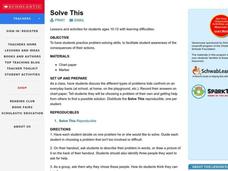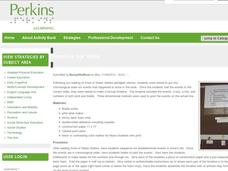Alabama Learning Exchange
Investigating School Safety and Slope
Learners investigate the slope of various stairways through a "news report" approach and employ mathematical knowledge of applied slope to report on wheelchair accessibility and adherence to Americans with Disabilities Act. They...
Curated OER
Sports for All
Third graders complete several sports activities with simulated disabilities. They reflect on the inherent difficulties and brainstorm modifications for each activity.
Curated OER
Discriminating Issues
Students examine how U.S. Law Defines Discrimination In this lesson. They research the issues surrounding a variety of types of discrimination, and then write editorials analyzing legal and social positions on discrimination in the...
Curated OER
8th Grade Special Needs P.E. Project
Eighth graders without a disability are encouraged to gain a new perspective about what it is like to have a physical disability. They experience various examples (blindfolding, soundproof ear protection, wheelchair, etc.) to begin to...
Curated OER
Health Education: An Integrated Approach; A Day Without Sight
Fourth graders hypothesize about the difficulties they may encounter if they did not have their sense of sight, in order to establish a sense of empathy for the disabled. In this activity on senses, 4th graders record all of the things...
Curated OER
Halloween Story with Portrayal Movement
Pupils imitate action words in the story and engage in cumulative movement patterns.
Perkins School for the Blind
Tug of War
Don't be fooled by how short this lesson is; it contains a good idea for adaptive PE. The activity is intended to help learners with visual impairments increase motor skills, muscle strength, and mobility. Two kids play a game of tug of...
Louisiana Department of Education
Essential Elements Cards
Use essential elements cards to help lesson plan! Each card contains an informational text common core standard for grade levels six through eight and suggestions for activities and supports. Cards address skills such as citing textual...
Curated OER
A Woman's Crusade: Dorothea Dix
Students examine the life and reform efforts of Dorothea Dix on behalf of people with disabilities. They also examine the role of women in the 1840s and 1850s. They discover different sources of examples of citizen's rights.
Curated OER
Physical Differences
Students role play what it would be like to have a physical disability. In this lesson on acceptance, students listen to the book A Rainbow of Friends by P.K. Hallinan. As a class, the students discuss similarities and differences in...
Curated OER
Seeing the World Through A Different Lens
Students participate in activities in which they model different disabilities. They discuss their experiences as a class. They work together in groups to discuss how to improve an adaptive device.
Curated OER
Stay in the Mix ...With Summer Service!
Students explore the concept of philanthropy. In this service learning lesson, students consider community service work they may complete when school is not in session.
Curated OER
Reading Without Seeing: Louis Braille and the Braille Alphabet
Students study Louis Braille and the history of the Braille alphabet. They participate in an activity using the sense of touch to determine how the Braille alphabet works.
Curated OER
Exploring Disability
Students explore through drama how disabled people may be treated by society.
Curated OER
Solve This
Students with learning disabilities practice their problem-solving skills. They discover the consequences of their actions and they chart their decisions. They use the internet to see how different situations play out based on different...
Perkins School for the Blind
Tactile quilts that tell a story
Learners with multiple disabilities need to engage in projects that push them to know their full potential. They need to be able to express themselves in a variety of ways, and this very thoughtful lesson does just that. They make a...
Center for Literacy and Disability Studies
Activities to Support Teaching the Alphabet
Whether or not your class includes kids with significant disabilities, teaching the alphabet to emergent readers and writers can be a challenge. Here's an activity packet designed for all learners.
Perkins School for the Blind
Making Choices
Here is an excellent and well-developed instructional activity intended to promote choice-making skills for learners with visual impairment and intellectual disabilities. It fosters choice-making skills through a soft version of discrete...
Curated OER
Lesson 6: Mittens, Socks, Mittens, Socks, Mittens!
Mittens and socks, two of my favorite clothing items! Young learners with special needs, explore clothing appropriate for cold weather. They identify both socks and mittens, discuss weather appropriate clothing, and listen to the story,...
Perkins School for the Blind
Integrated Skills - Laundry
I hate doing laundry, even if it is an independent living skill that requires me to count money, follow a sequence, and sort clothing by color. Learners with multiple disabilities discuss what laundry is, why they need to do it, and how...
Teachers Network
A World of Symmetry: Math-Geometry
Define and identify the three basic forms of symmetry translation, rotation, and glides with your class. They cut out and arrange paper pattern blocks to illustrate symmetry, create a Cartesian graph, and design a rug with a symmetrical...
Perkins School for the Blind
Timeline for Anne
It is key to the learning process to make everything a child with visual impairments does as tactile as possible. After reading Anne of Green Gables, the class discusses her life events in order to make a tactile time line. They choose...
Curated OER
Exploration of Utopias and Dystopias
If you are considering adding or expanding a unit on utopian and dystopian literature you simply must check out this fabulous resource. Packed with plans, activities, project-based and 21st century learning opportunities, the unit uses a...
Curated OER
Conducting a Functional Behavior Assessment
This is an excellent guideline for an observer to use when conducting an assessment for a student who has a chronic behavior problem. The chart has 3 categories--antecedent, behavior, consequences--and clear examples to guide you.

























